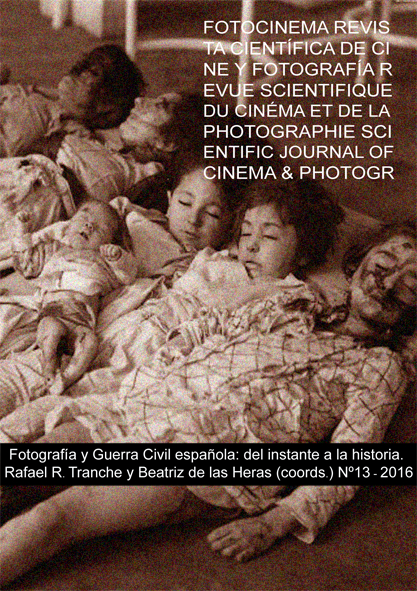Imaginarios del cuerpo y la memoria del cine contemporáneo: reflexiones sobre el cine de Miguel Gomes y Joao Pedro Rodrigues
DOI:
https://doi.org/10.24310/Fotocinema.2016.v0i13.6064Abstract
La historia de la representación humana ha sido, de alguna manera, la de la representación del cuerpo. La atención sobre los procesos de formación del sujeto viene siendo una constante de la estética y la creación contemporánea desde los años sesenta,y la teoría social lo percibió como problema y temática poco después. A las representaciones audiovisuales el cuerpo ha llegado especialmente desde los campos del videoperformance aunque más recientemente de la mano de la creación fílmica contemporánea. En primer lugar, en el trabajo se realiza un análisis del cine actual a través de conceptos como los de embodiment (Merleau-Ponty) o gestus (Deleuze), especialmente en obras como O fantasma (2000), Odete (2005) o Morrer come um homem (2009), todas de Joao Pedro Rodrigues, cineasta luso. En segundo lugar, el trabajo sobre la memoria y el pasado colonial se encuentra en el centro de las películas de Miguel Gomes como Tabú (2012) o Aquele querido mês de agosto (2008).
Abstract:
The history of human representation has been the representation of the body. The attention to the processes of formation of the subject is still a constant of aesthetics and contemporary art since the sixties, and social theory perceived it as a problem and issue. The body has come to the audiovisual performances from the fields of video performance, and even more recently by the hand of contemporary filmmaking. First of all, in this paper we analyse some films through concepts about the body such as embodiment (Merleau-Ponty) or gestus (Deleuze), especially in works such as O Fantasma (2000), Odete (2005) or Morrer come um Homem (2009), by the Portuguese filmmaker Joao Pedro Rodrigues. On the second hand, the cinematic work about memory and colonial past is in the center of Miguel Gomes´ movies, such as Tabu (2012) or Aquele querido mês de agosto (2008).
Palabras clave:
cine portugués; cine contemporáneo; Miguel Gomes; Joao Pedro Rodrigues; cuerpo en ciencias sociales
Keywords:
Portuguese cinema; contemporary cinema; Miguel Gomes, Joao Pedro Rodrigues; body in social sciencesDownloads
Metrics
Publication Facts
Reviewer profiles N/A
Author statements
Indexed in
-
—
- Academic society
- N/A
- Publisher
- Universidad de Málaga
Downloads
Published
How to Cite
Issue
Section
License
All contents published in Fotocinema Revista científica de cine y fotografía are protected under the Creative Commons Attribution-NonCommercial-ShareAlike 4.0 International (CC BY-NC-SA 4.0) license. All about this license is available in the following link: <http://creativecommons.org/licenses/by-nc-sa/4.0>
Users can copy, use, redistribute, share and exhibit publicly as long as:
- The original source and authorship of the material are cited (Journal, Publisher and URL of the work).
- It is not used for comercial purposes.
- The existence of the license and its especifications are mentioned.
There are two sets of authors’ rights: moral and property rights. Moral rights are perpetual prerogatives, unrenounceable, not-transferable, unalienable, imprescriptible and inembargable. According to authors’ rights legislation, Fotocinema. Revista científica de cine y fotografía recognizes and respects authors moral rights, as well as the ownership of property rights, which will be transferred to University of Malaga in open access. The property rights are referred to the benefits that are gained by the use or the dissemination of works. Fotocinema. Revista científica de cine y fotografía is published in an open access form and it is exclusively licenced by any means for doing or authorising distribution, dissemination, reproduction, , adaptation, translation or arrangement of works.
Authors are responsable for obtaining the necessary permission to use copyrighted images.














13.png)



